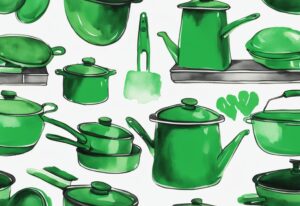Palm Wax vs Soy Wax: A Comprehensive Comparison Guide
Ever stand in the aisle of a candle shop, a beautifully crafted palm wax candle in one hand and a divine smelling soy wax one in the other, utterly torn? It’s a quandary many of us candle enthusiasts face—palm wax or soy wax, which one to choose?
In this guide, we’ll delve into the heart of the matter, untangling the web of the palm versus soy wax debate. From their sustainability and burn time to overall performance, you’ll gain a clear understanding of what each wax brings to your candle-loving table.
By the end of our journey, you’ll be well-equipped with the knowledge you need to make an informed decision— picking the best wax that aligns not just with your needs but your values too. So go on, step into the empowering light of knowledge with me. Let’s explore the battle between palm wax and soy wax together.
Unpacking Palm Wax and Soy Wax: A Brief Introduction
Palm wax, an eco-friendly choice, is derived from the hydrogenation of palm oils. As a 100% organic and chemical-free option, it resonates with those seeking natural candle alternatives. From my personal experience, the longer burn time of palm wax candles is truly remarkable. It not only extends the life of the candle but also maintains its scent more effectively over time. This consistency ensures a lingering aromatic experience that I always look forward to.
Soy wax, alternatively, is produced from soybean oil combined with other vegetable components. This renewable resource is lauded for its clean burn, which significantly reduces soot and smoke. In my journey towards a healthier home, I’ve found soy wax to be an excellent choice. Its ability to hold fragrances well means that scented candles made from soy wax offer a wonderfully pleasing sensory experience.
Both palm and soy waxes are vegan-friendly options, aligning well with environmentally conscious lifestyles. When comparing palm wax vs soy wax, each presents unique characteristics catering to different preferences.
Palm wax’s longevity and superior scent retention stand out, particularly if, like me, you enjoy a long-lasting candle with a steady fragrance. On the other hand, soy wax has earned a reputation for its cleaner burn and effective fragrance absorption, ideal for anyone prioritizing air quality at home. This differentiation greatly aids in choosing the wax that best suits your needs and values.
As you navigate this choice, remember that both options align well with the principles of non-toxic living, promoting both personal health and environmental sustainability.
Is there a Greener Choice? Palm Wax vs Soy Wax Environmental Impact
Effects on Deforestation and Wildlife Habitats
The production of palm wax has significant environmental repercussions, closely tied to deforestation and the endangerment of wildlife habitats. In regions like Indonesia and Malaysia, expansive palm oil plantations have led to the clearing of vast tropical rainforests, raising significant environmental concerns that are detailed in studies on the topic, such as those found at this resource. This habitat destruction displaces wildlife and severely impacts biodiversity. Orangutans, for instance, face existential threats as their natural habitats are decimated.
Soy wax production, on the other hand, involves intensive farming practices that contribute to soil erosion and water contamination. The cultivation of soybeans demands considerable fertilizer and pesticide inputs. While soy wax production doesn’t directly cause deforestation, its environmental footprint is nonetheless significant. Both palm and soy wax production reveal a pattern of ecological damage, demonstrating that neither is devoid of environmental concerns.
Assessing Carbon Emissions and Ozone Impact
One of the gravest issues associated with palm wax production is its contribution to carbon dioxide emissions. Deforestation for palm oil plantations releases vast amounts of stored carbon into the atmosphere, exacerbating climate change and affecting the ozone layer. This process, in turn, impacts air quality and drives global warming.
Soy wax does somewhat better concerning farming-related emissions, but it still requires extensive resources for production. The farming and processing of soybeans, including machinery and transport, consume fossil fuels and emit greenhouse gases. Both palm wax and soy wax possess substantial carbon footprints, necessitating a critical evaluation of their sustainability claims.
Palm Wax and Soy Wax: Examining Sustainability
Palm wax boasts rapid renewability, with palm oil harvests occurring within days or weeks. While this can be advantageous economically, it often comes at the tremendous cost of deforestation and natural resource exploitation. This includes not just habitat destruction but also significant resource depletion, raising concerns about the long-term benefits of palm wax.
In comparison, soy wax takes longer to renew, requiring weeks or months for soybean growth. This slower cycle has its advantages, supporting American agriculture and providing a stable income for U.S. farmers. Soy wax and palm wax both avoid petrochemicals, making them cleaner choices compared to paraffin wax. Yet, marketing claims that one is decidedly more eco-friendly than the other should be approached with caution.
Both palm wax and soy wax present complex environmental trade-offs. While they offer certain ecological benefits, neither is devoid of issues. It’s crucial to consider the broader implications of each, moving beyond surface-level claims to understand their true environmental impact.

Making the Cut: How Palm Wax and Soy Wax are Produced
Curious about how palm wax and soy wax come to life? Let’s dive into the fascinating processes behind these two popular waxes.
The Palm Wax Production Process
Palm wax, harvested from the fruits of palm trees, goes through an intricate refining process. To start, palm oil is extracted from the palm fruits. This oil is then subjected to hydrogenation, transforming it from a liquid into a solid, crystallized wax.
The beauty of palm wax production lies in its efficiency; it requires fewer resources and less land compared to other methods. This exemplifies a more resource-conscious approach, especially relevant in the debate of palm wax vs soy wax.
The Secrets Behind Soy Wax Production
Soy wax also begins its journey with oil extraction, but here it’s from soybeans. Much like palm wax, the soybean oil undergoes hydrogenation, solidifying it for use in candles. However, the journey from farm to candle for soy wax is more intricate than it seems.
Remarkably, 96% of soybeans cultivated worldwide are genetically modified, or GMO, which stirs quite a bit of controversy in organic markets. Intensive farming practices for these soybeans often involve significant use of pesticides and chemicals, which can linger in the final product.
Moreover, soy wax production may incorporate other vegetable components to achieve an ideal consistency for candle crafting. This complex process teeters between efficiency and environmental impact, a critical point in ongoing discussions about palm wax vs soy wax.
By understanding these production processes, you can make more informed choices for your non-toxic living journey. Each type of wax has its unique strengths and considerations, making your choice in the palm wax vs soy wax debate a personal one that impacts both your health and the planet.
What’s They’re Really Made Of: Biodegradability and Chemical Composition
Understanding the core differences between palm wax and soy wax, especially in terms of biodegradability and chemical composition, can help you make more sustainable and health-conscious choices.
Can Palm Wax Break Down Naturally?
Palm wax is renowned for its 100% biodegradable nature. This environmentally friendly attribute means it can easily decompose in natural settings, reducing waste. Additionally, it is water-soluble, ensuring that spills are straightforward to manage. Simply use soap and water for clean-up without worrying about toxic residues.
Is Soy Wax Truly Biodegradable?
Pure soy wax, derived from soybean oil, is biodegradable and water-soluble, making it an eco-friendly option. However, the addition of impurities during the production process can compromise these properties. Such impurities can render soy wax non-biodegradable and alter its ability to dissolve in water, affecting its overall environmental footprint.
Understanding the Chemical-free Benefits of Palm Wax
Palm wax stands out for its chemical-free composition. Extracted from natural palm fruitlets, it contains no synthetic additives, making it a non-toxic choice. This feature not only preserves air quality when burned but also ensures that the wax is safe for both the environment and consumers.

Unraveling the Mystery: Impurities in Soy Wax
Unlike palm wax, soy wax undergoes chemical refinement processes that can introduce substances like acrylic acid and ethylene. These chemicals, coupled with pesticide residues from intensive soybean farming, may remain in the final product. This presence of impurities highlights a significant distinction in the palm wax vs soy wax debate, especially for those prioritizing chemical-free and non-toxic products.
The Performance Test: Comparing Palm Wax and Soy Wax Burning Characteristics
Duration of Burning: Which Wax Lasts Longer?
When it comes to palm wax vs soy wax, one significant difference lies in the burn duration. Palm wax is cherished for its longer burn times, making it an economical choice for those seeking candles that endure. Its unique structure ensures a slow and consistent burn, offering more hours of enjoyment per candle.
Comparatively, while soy wax also burns slowly against some other waxes, it doesn’t quite match the longevity of palm wax. This means that although soy wax provides a sustainable and eco-friendly option, it may need replacement sooner than its palm wax counterpart.
Scent Retention: Does Palm Wax or Soy Wax Win Out?
An essential aspect of candles is their ability to maintain and diffuse fragrance effectively. In the comparison of palm wax vs soy wax, palm wax excels by retaining and evenly releasing scent throughout its burn time. This ensures a consistent aromatic experience, favored by users who value a lasting fragrance.
On the other hand, soy wax, while commendable for holding fragrances well, sometimes loses its scent intensity within the first hour or more of burning. This indicates that the initial fragrance burst might diminish more quickly compared to palm wax.
The Truth About Clean Burning and Soot Production
Both palm and soy waxes are praised for their clean-burning properties, significantly outperforming paraffin wax by producing no black soot. When considering palm wax vs soy wax, both options present an eco-friendly choice with minimal soot, contributing to a healthier indoor environment.
Soy wax is particularly praised for its virtually soot-free performance, enhancing its appeal for eco-conscious consumers. Palm wax, equally impressive, offers a virtually drip-less and soot-free burn, maintaining a clean and refined atmosphere during use.
For the Crafters: Aesthetic and Crafting Qualities
Palm Wax vs. Soy Wax: A Visual Comparison
Palm wax candles, with their distinctive crystal pattern, add a touch of elegance to any room. This unique texture, born from the wax’s crystalline structure, can make your candles stand out as high-end decor items.
Conversely, soy wax candles bring a smooth, even look that’s consistent and reliable. But don’t be surprised if they change slightly over time. Environmental factors like temperature and humidity can cause this transformation, altering the candle’s initial appearance.
Which is More Craft-Friendly? Exploring Texture and Workability
When diving into crafting, I often find soy wax to be the go-to option. Its soft, pliable texture is a dream to mold—perfect for intricate, artisanal projects. You can shape it just the way you want, which is wonderful for those DIY endeavors.
Meanwhile, palm wax is known for its firmness and higher melting point. This firmness means fewer air bubbles and aesthetic imperfections, leading to a cleaner, more polished final product. The durability of palm wax helps your candles retain their shape longer, ensuring lasting beauty.
Understanding Compatibility with Colors and Fragrances
Both palm wax and soy wax excel in integrating colors and fragrances, making them versatile for both scented and decorative candles. Palm wax is particularly good at releasing a continuous, even scent throughout its burn time, providing a steady aroma that can fill a room.
Soy wax also holds onto fragrances well, though it may diffuse scents more gradually. This subtle difference in scent throw could influence your choice, depending on the aroma experience you’re aiming for. As for color, both waxes are highly adaptable and can be dyed with a rich palette, letting your creativity shine through in every hue and shade you choose.
Vote with Your Wallet: Market and Consumer Preferences
Tracking Trends: Is Palm Wax or Soy Wax More Popular?
When it comes to consumer preferences, soy wax is steadily gaining traction due to its eco-friendly reputation. Many consumers are drawn to soy wax candles because of their clean burn and sustainable production methods. This surge in popularity is largely attributed to increasing awareness of environmental issues and a shift towards greener alternatives.

On the other hand, palm wax is also carving out a niche for itself, mainly because of its unique crystalline appearance and longer burn time. Aesthetics play a significant role in consumer choices, making palm wax a favorite for those seeking visually appealing and longer-lasting candles.
The Cost Showdown: Palm Wax vs Soy Wax
Cost is a crucial factor in the palm wax vs soy wax debate. Generally, soy wax candles are more affordable. This affordability stems from the more abundant and cheaper raw materials involved in soy wax production, as well as simpler manufacturing processes.
In contrast, palm wax candles are often pricier. The higher cost can be attributed to the distinct visual features and extended burn times that palm wax offers. Consumers willing to spend a bit more often appreciate the unique look and durability of palm wax candles, justifying the higher price point.
A Look at Market Availability
The market availability of these two wax types reflects current consumer preferences. Soy wax candles are widely available due to their growing popularity and demand for eco-friendly products. This wide availability ensures that consumers can easily find a variety of soy wax candles in stores and online.
Conversely, palm wax candles, while available, may not be as ubiquitous. The niche appeal and higher production costs can limit their distribution. Nonetheless, those who seek out palm wax candles often find that the effort is rewarded with a product that offers distinctive aesthetic qualities and performance benefits.
Decoding Palm Wax vs Soy Wax: Conclusion
When choosing between palm wax and soy wax, several factors come into play. Your decision will hinge on personal preferences related to environmental impact, burn time, scent retention, and even visual appeal. Both waxes offer unique benefits and drawbacks, making it crucial to weigh your options carefully.
Palm wax is celebrated for its longer burn time and mesmerizing crystalline appearance, making it a favorite for those who value both longevity and aesthetics. It maintains its scent longer during burning, delivering a consistently aromatic experience. However, palm wax production is often criticized for its environmental impact, particularly deforestation and habitat loss in regions like Indonesia and Malaysia.
On the other hand, soy wax is lauded for its clean burn and ability to hold fragrances well, releasing them gradually and gently. Its production supports the agricultural economy by utilizing soybeans grown primarily in the U.S., which can be a deciding factor for eco-conscious enthusiasts. Nonetheless, soy wax farming practices can lead to soil erosion and water contamination. Though generally seen as more environmentally friendly, potential impurities and chemicals used during farming and production need to be considered.
From a sustainability perspective, palm wax can be renewed more quickly, despite often involving harmful practices like deforestation. Soy wax takes longer to renew but contributes positively to the agricultural sector.
When it comes to crafting, soy wax’s soft and pliable texture makes it more craft-friendly—ideal for DIY projects. Palm wax, with its higher melting point and harder texture, is less prone to developing air bubbles, thus maintaining its aesthetic qualities.
Ultimately, the choice between palm wax and soy wax depends on your values and priorities. Consider the sustainability of production, chemical composition, and crafting qualities. Both waxes have unique attributes catering to different needs and preferences.
By understanding the complexities of palm wax vs soy wax, you can make informed decisions that align with your environmental values and crafting needs. Whether you prefer the unique look and extended burn of palm wax or the clean burn and crafting versatility of soy wax, both options provide viable, non-toxic alternatives for candle making.
Setting the Record Straight: FAQ
What Sets Palm Wax Apart from Soy Wax?
Palm wax is 100% biodegradable and distinctively harder, flaunting a unique crystal-like appearance. Imagine a candle with beautiful shapes and textures; that’s the charm of palm wax. Conversely, soy wax offers a softer texture and burns cleaner, often celebrated for its eco-friendly and sustainable production. When I first switched to soy candles, I noticed how much cleaner my air seemed.
Which Wax Holds the Long-Burning Crown: Palm or Soy Wax?
Palm wax typically has a longer burn time compared to soy wax, thanks to its more solid structure. This durability makes it a top choice if you’re looking for candles that last longer. Having tested both, I’ve found that palm wax candles often light up my evenings for several extra hours compared to their soy counterparts.
Palm Wax or Soy Wax: Who Wins the Environmental Friendliness Medal?
Soy wax tends to be more eco-friendly due to its production involving fewer environmental concerns. On the flip side, palm wax poses significant environmental issues, such as deforestation and habitat loss. These factors make a huge difference, especially if you’re keen on making sustainable choices. Personally, the deforestation issue associated with palm wax really swayed me towards using soy.
Palm Wax vs Soy Wax: Which Holds Scent Better?
Palm wax excels at maintaining and releasing scent evenly throughout its burn time. This characteristic ensures a consistent aromatic experience. Soy wax, although excellent at holding fragrances, tends to release scent more gradually and subtly as it burns. In my experience, soy candles provide a gentle yet enduring fragrance that’s perfect for creating a serene ambiance.
Hi, I’m Olivia Green, the voice behind nontoxicways.com. I’m passionate about helping you make the shift to a healthier, non-toxic lifestyle without feeling overwhelmed. I love sharing my personal journey, from small changes to big transformations, along with practical tips that make it all feel doable. My goal is to inspire and guide you toward a lifestyle that benefits both your well-being and the planet. Let’s take this journey together, one simple step at a time!














Post Comment